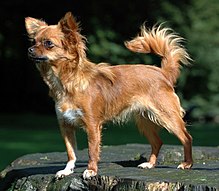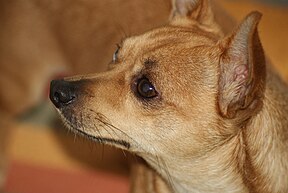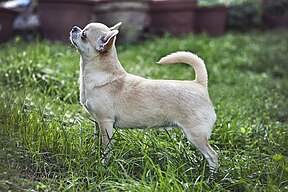Chihuahua (dog breed)
| Chihuahua | |||||||||||||||||||||||||
|---|---|---|---|---|---|---|---|---|---|---|---|---|---|---|---|---|---|---|---|---|---|---|---|---|---|
 | |||||||||||||||||||||||||
| Other names | Chihuahueño | ||||||||||||||||||||||||
| Origin | Mexico | ||||||||||||||||||||||||
| |||||||||||||||||||||||||
| |||||||||||||||||||||||||
| Dog ( domestic dog ) | |||||||||||||||||||||||||
The Chihuahua
History
Colonial records refer to small, nearly hairless dogs at the beginning of the nineteenth century; one claims that sixteenth-century
The American Kennel Club first registered a Chihuahua in 1904, Midget, owned by H. Raynor of Texas.[8][9]
Characteristics
Chihuahuas are the smallest breed recognized by some kennel clubs.[10] Current breed standards defined by registries specify an "apple-head" or "apple-dome" skull conformation.[11] Chihuahuas occur in virtually any color combination, from solid to marked or splashed.[12] Apple-dome Chihuahuas have large, round eyes and large, erect ears, set in a high, dramatically rounded skull.[10] The stop is well defined, forming a near-90-degree angle where the muzzle meets the skull.[13] Dogs of the older "deer" type, with a flat-topped head, more widely set eyes, larger ears, and longer, more slender legs, may still be registered, but the deer head is not considered a separate type in competition and a deer-head dog's digression from the breed standard is considered a fault.[11][13]
Breed standards for this dog do not generally specify a height; only a weight and a description of their overall proportions. Generally, the height ranges between 6 and 9 in (15 and 23 cm);[10] however, some dogs grow as tall as 30 to 38 cm (12 to 15 in). Both British and American breed standards state that a Chihuahua must not weigh more than 5.9 lb (2.7 kg) for conformation.[10]
However, the British standard also states that a weight of 4–6 lb (1.8–2.7 kg) is preferred. A clause stating "if two dogs are equally good in type, the more diminutive one is preferred" was removed in 2009.[14] The Fédération Cynologique Internationale standard calls for dogs ideally between 1.5 and 3.0 kg (3.3 and 6.6 lbs), although smaller ones are acceptable in the show ring.[15]
Pet Chihuahuas (those bred or purchased as companions rather than as show dogs) often range above these weights, even above 10 lb (4.5 kg), if they have large bone structures or are allowed to become overweight.
The Fédération Cynologique Internationale, which represents the major kennel clubs of 84 countries, disqualified the merle coat pattern, which appears mottled.[15] In May 2007, The Kennel Club decided not to register puppies with this coloration due to the health risks associated with the responsible gene, and in December of that year, formally amended its breed standard to disqualify merle dogs.[17]
Like many other small dogs, the Chihuahua may display above-average aggression toward people and other dogs.[18][19]

Health
The Chihuahua has some
A 2018 study in Japan of pet cemetery data found the Chihuahua to have an average life expectancy of 11.8 years compared to 15.1 for crossbreeds and 13.7 overall.[26] A 2022 UK study on life expectancy of dog breeds based on veterinary data showed the average life expectancy to be 7.91 for the breed compared to 11.82 years for crossbreeds.[27][b] A 2024 UK study found a life expectancy of 11.8 years for the breed compared to an average of 12.7 for purebreeds and 12 for crossbreeds.[28]
A UK study found the Chihuahua bitch to be more than 10.4 times more likely to experience
See also
- List of dog breeds
- Ren Hoek from Nickelodeon's The Ren & Stimpy Show
- Beverly Hills Chihuahua
- Chihuahua (state)
Notes
- ^ English: /tʃɪˈwɑːwə, -wɑː, -ˈwaʊ.ə/ ⓘ; Spanish: [tʃiˈwawa].[30]
- ^ The Japanese study reviewed cemetery data which is unlikely to have any records of still-births and altricial deaths whilst a veterinary clinic likely would have data on these.
References
- ^ FCI-Standard N° 218: Chihuahueño (Chihuahua). Fédération Cynologique Internationale. Accessed October 2022.
- ^ ISBN 9780241412732.
- ^ "The 25 Smallest Dog Breeds". American Kennel Club. Retrieved January 26, 2021.
- S2CID 206663458.
- S2CID 225956269.
- ^ Pedro Baptista Pino y Juan Lopez Cancelada, Exposición sucinta y sencilla de la Provincia del Nuevo México y otros escritos. Ed. Jesus Paniagua Perez. Valladolid: Junta de Castilla / León: Universidad de León, 2007, p. 244: "even in the desert the tiny dogs could be found, hunting rats, mice, and lizards." The footnote that follows alludes to starving Conquistadores reportedly hunting and stewing the dogs (Universidad Veracruzana, Arquivo Viejo, XXVI.2711).
- ^ "Hernan Cortés: from Second Letter to Charles V, 1520". Fordham University. Archived from the original on August 23, 2014. Retrieved March 25, 2014.
- ^ Coile, C. (2013). Chihuahuas: Everything about purchase, care, nutrition, behavior, and training. Hauppauge, NY: Barron's Educational Series, p. 7: "Only in 1904 did the American Kennel Club (AKC) register its first Chihuahua; a total of five were registered that year."
- ^ "Chihuahua History: From Aztec Treasure to Popular Companion". American Kennel Club. January 6, 2022. Retrieved September 28, 2022.
- ^ ISBN 978-0-7368-0158-4. Retrieved March 1, 2013.
- ^ ISBN 9781440523687. Retrieved June 15, 2019.
- ^ American Kennel Club Chihuahua page, retrieved on July 29, 2007.
- ^ a b "Official Standard of the Chihuahua" (PDF). Retrieved November 12, 2019.
- ^ "The Kennel Club". thekennelclub.org.uk. Archived from the original on October 30, 2017. Retrieved October 17, 2013.
- ^ a b "Chihuahua standard" (PDF). Fédération Cynologique Internationale. July 28, 2009. Retrieved October 25, 2011.
- ProQuest 441596979.
- ^ "Kennel Club breed standard". Thekennelclub.org.uk. May 15, 2006. Archived from the original on January 3, 2009. Retrieved August 14, 2009.
- . (subscription required).
- .
- ISBN 9781119946113, pages 1–8.
- ^ Chihuahua (long and smooth coat): Hydrocephalus. Genetic Welfare Problems of Companion Animals. Wheathampstead, Hertfordshire: The International Animal Welfare Science Society/Universities Federation for Animal Welfare. Accessed February 2021.
- .
- ^ V. Butković, M. Šimpraga, M. Šehić, et al. (2001) Dental diseases of dogs: a retrospective study of radiological data. Acta Veterinaria Brno. 70: 203–208.
- .
- ISBN 9781405107488.
- PMID 29798968.
- PMID 35484374.
- PMC 10834484.
- ^ Packer, Rowena. "New study reveals flat faced dogs have the highest risk when giving birth". Royal Veterinary College. University of London. Retrieved March 13, 2024.
- ISBN 978-1-4058-8118-0.


